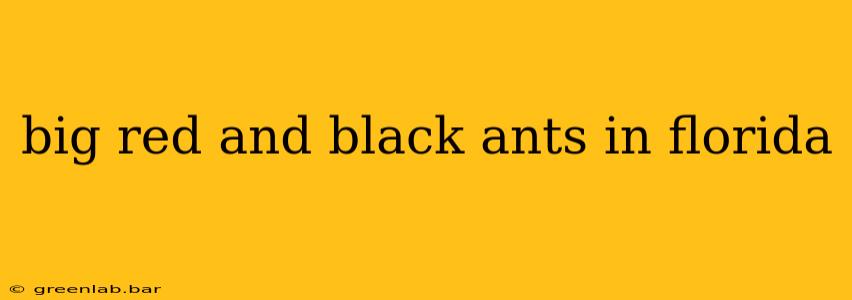Florida's warm climate provides a haven for a diverse range of ant species, some of which are quite striking in their appearance. Among the most noticeable are the large, red and black ants that often invade homes and gardens. This guide will help you identify these ants and provide effective strategies for control. Understanding the species is key to successful management, as different ants respond to different treatments.
Identifying Florida's Big Red and Black Ants
Several ant species in Florida exhibit a striking red and black coloration. Pinpointing the exact species is crucial for effective control, as treatment methods vary. Some of the most common culprits include:
1. Florida Carpenter Ants ( Camponotus floridanus)
These ants are often large (½ inch or more), with a distinctly bicolor appearance: a black head and thorax, and a reddish-brown abdomen. They are known for nesting in wood, but unlike termites, they don't consume the wood itself – they excavate it to create galleries. This can cause significant structural damage if left untreated. Look for sawdust-like frass near potential nesting sites.
2. Black Carpenter Ants ( Camponotus pennsylvanicus)
While predominantly black, some variations may exhibit reddish-brown hues, especially on their legs and abdomen. These ants, similar to their Florida cousins, nest in wood and can cause considerable damage. They are slightly smaller than Camponotus floridanus.
3. Other Potential Species
Several other ant species might present a red and black appearance, though less dramatically. Precise identification often requires close examination or professional assistance from an entomologist. Factors to consider include size, body shape, and the presence of specific markings. Detailed photographs can be helpful for accurate identification.
Controlling Big Red and Black Ants in Florida
Effective control requires a multi-pronged approach combining preventative measures and targeted treatments.
1. Preventative Measures:
- Proper sanitation: Clean up spills immediately, store food in airtight containers, and regularly clean counters and floors. Ants are attracted to food sources.
- Eliminate moisture: Repair leaks, address water damage, and ensure proper ventilation to reduce attractive environments for ants.
- Seal entry points: Caulk cracks and crevices in walls, foundations, and windows to prevent ant entry.
- Regular yard maintenance: Keep grass trimmed, remove debris, and prune overhanging branches to limit ant access to your home.
2. Targeted Treatments:
- Baiting stations: These are highly effective for controlling ant colonies. The bait attracts worker ants, who then carry it back to the nest, eliminating the queen and the entire colony. Different baits are formulated for specific ant species, so choosing the right one is crucial.
- Insecticides: Spot treatments with insecticides may provide temporary relief, but they often only kill visible ants and not the entire colony. Use caution and follow all label instructions.
- Professional pest control: For severe infestations or if DIY methods fail, consult a professional pest control service. They have access to advanced treatments and can identify the species accurately.
Conclusion
Dealing with large red and black ants in your Florida home or garden can be challenging. Accurate identification, combined with a comprehensive approach encompassing preventative measures and targeted treatments, is crucial for successful and long-term control. Remember, early detection and intervention are key to minimizing damage and preventing larger infestations. If you're unsure about the ant species you are dealing with, seeking professional help is always recommended.

